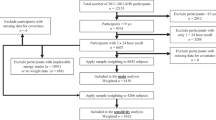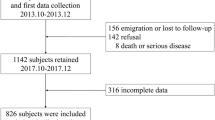Abstract
Objectives:
Raised glycosylated haemoglobin (HbA1c) concentration is a recognized risk factor for diabetes, the incidence of which is rising worldwide. The intake of certain foods has been related to HbA1c concentration. The aim of this study was to investigate whether nutrient intake, sourced by these foods, was predictive of raised glycosylated haemoglobin (HbA1c) concentration in a British cohort.
Subjects:
The subjects were 495 men and 570 women who were members of the Medical Research Council National Survey of Health and Development, 1946 birth cohort.Diet was assessed from 5-day records in 1982, 1989 and 1999. HbA1c was measured in blood samples collected in 1999. Individuals in whom concentration of HbA1c was ⩾6.3% were identified as being ‘at risk’ and their nutrient intake was compared with those whose concentration of HbA1c was within the normal range (⩽6.2%).
Results:
Lower intakes of protein, carbohydrate, non-starch polysaccharide, iron, folate, vitamin B12 and a higher percentage energy from fat in 1989 were significantly predictive of high HbA1c status in 1999. In 1999, there were no nutrient intakes that were predictive of HbA1c status. Global tests of whether the intakes of energy, carbohydrate, sodium, iron, riboflavin and vitamin B12 at all three time points were related to HbA1c status in 1999, were significant.
Conclusion:
An increased intake of energy, carbohydrate, sodium, iron, riboflavin and vitamin B12 over 10 years was predictive of raised HbA1c status. Increased energy intake may have resulted in increase in body weight, which is a risk factor for diabetes.
This is a preview of subscription content, access via your institution
Access options
Subscribe to this journal
Receive 12 print issues and online access
$259.00 per year
only $21.58 per issue
Buy this article
- Purchase on Springer Link
- Instant access to full article PDF
Prices may be subject to local taxes which are calculated during checkout
Similar content being viewed by others
References
Adler AI (2008). UKPDS-modelling of cardiovascular risk assessment and lifetime simulation of outcomes. Diabet Med 25 (Suppl 2), 41–46.
Bates CJ, Lean ME, Mansoor MA, Prentice A (2004). Nutrient intakes; biochemical and risk indices associated with Type 2 diabetes and glycosylated haemoglobin, in the British National Diet and Nutrition Survey of people aged 65 years and over. Diabet Med 21, 677–684.
Bazzano LA, Li TY, Joshipura KJ, Hu FB (2008). Intake of fruit, vegetables, and fruit juices and risk of diabetes in women. Diabetes Care 31, 1311–1317.
Bingham SA, Cassidy A, Cole TJ, Welch A, Runswick SA, Black AE et al. (1995). Validation of weighed records and other methods of dietary assessment using the 24 h urine nitrogen technique and other biological markers. Br J Nutr 73, 531–550.
Boeing H, Weisgerber UM, Jeckel A, Rose HJ, Kroke A (2000). Association between glycated hemoglobin and diet and other lifestyle factors in a nondiabetic population: cross-sectional evaluation of data from the Potsdam cohort of the European Prospective Investigation into Cancer and Nutrition Study. Am J Clin Nutr 71, 1115–1122.
Bolton-Smith C, Price RJG, Fenton ST, Harrington DJ, Shearer MJ (2000). Compilation of a provisional UK database for the phylloquinone (vitamin K-1) content of foods. Br J Nutr 83, 389–399.
Department for Environment Food and Rural Affairs (2001). National Food Survey 2000. The Stationery Office: London.
Diabetes UK (2007). Diabetes in the UK 2007,www.diabetes.org.uk/Professionals/Information_resources/Reports/Diabetes-prevalence-2007/.
Food Standards Agency (2002). McCance and Widdowson's The Composition of Foods. Royal Society of Chemistry: Cambridge.
Ford ES, Williamson DF, Liu S (1997). Weight change and diabetes incidence: findings from a national cohort of US adults. Am J Epidemiol 146, 214–222.
Fung TT, Schulze M, Manson JE, Willett WC, Hu FB (2004). Dietary patterns, meat intake, and the risk of type 2 diabetes in women. Arch Intern Med 164, 2235–2240.
Gulliford MC, Ukoumunne OC (2001). Determinants of glycated haemoglobin in the general population: associations with diet, alcohol and cigarette smoking. Eur J Clin Nutr 55, 615–623.
Harding AH, Day NE, Khaw KT, Bingham SA, Luben RN, Welsh A et al. (2004). Habitual fish consumption and glycated haemoglobin: the EPIC-Norfolk study. Eur J Clin Nutr 58, 277–284.
Harding AH, Sargeant LA, Khaw KT, Welch A, Oakes S, Luben RN et al. (2002). Cross-sectional association between total level and type of alcohol consumption and glycosylated haemoglobin level: the EPIC-Norfolk Study. Eur J Clin Nutr 56, 882–890.
Harding AH, Sargeant LA, Welch A, Oakes S, Luben RN, Bingham S et al. (2001). Fat consumption and HbA(1c) levels: the EPIC-Norfolk study. Diabetes Care 24, 1911–1916.
Harding AH, Wareham NJ, Bingham SA, Khaw K, Luben R, Welch A et al. (2008). Plasma vitamin C level, fruit and vegetable consumption, and the risk of new-onset type 2 diabetes mellitus: the European prospective investigation of cancer—Norfolk prospective study. Arch Intern Med 168, 1493–1499.
Holland B, Unwin ID, Buss DH (1988). Cereals and Cereal Products: Third supplement to McCance and Widdowson's The Composition of Foods. Royal Society of Chemistry and Ministry of Agriculture, Fisheries and Food: Nottingham.
Holland B, Unwin ID, Buss DH (1989). Milk and Milk Products: Fourth Supplement to McCance and Widdowson's The Composition of Foods. Royal Society of Chemistry and Ministry of Agriculture, Fisheries and Food: Cambridge.
Khaw KT, Wareham N, Luben R, Bingham S, Oakes S, Welch A et al. (2001). Glycated haemoglobin, diabetes, and mortality in men in Norfolk cohort of European Prospective Investigation of Cancer and Nutrition Study (EPIC-Norfolk). Br Med J 322, 15–18.
Kirk JK, Graves DE, Craven TE, Lipkin EW, Austin M, Margolis KL (2008). Restricted-carbohydrate diets in patients with type 2 diabetes: a meta-analysis. J Am Diet Assoc 108, 91–100.
Lawlor DA, Ebrahim S, Timpson N, Davey Smith G (2005). Avoiding milk is associated with a reduced risk of insulin resistance and the metabolic syndrome: findings from the British Women's Heart and Health Study. Diabet Med 22, 808–811.
Livesey G, Taylor R, Hulshof T, Howlett J (2008). Glycemic response and health—a systematic review and meta-analysis: relations between dietary glycemic properties and health outcomes. Am J Clin Nutr 87, 258S–268S.
Mann JI (2002). Diet and risk of coronary heart disease and type 2 diabetes. Lancet 360, 783–789.
McNaughton SA, Mishra GD, Stephen AM, Wadsworth ME (2007). Dietary patterns throughout adult life are associated with body mass index, waist circumference, blood pressure, and red cell folate. J Nutr 137, 99–105.
Medical Research Council (2002). Current and Future Research on Diabetes. Department of Health: London.
Montonen J, Jarvinen R, Heliovaara M, Reunanen A, Aromaa A, Knekt P (2005b). Food consumption and the incidence of type II diabetes mellitus. Eur J Clin Nutr 59, 441–448.
Montonen J, Knekt P, Harkanen T, Jarvinen R, Heliovaara M, Aromaa A et al. (2005a). Dietary patterns and the incidence of type 2 diabetes. Am J Epidemiol 161, 219–227.
Papakonstantinou E, Panagiotakos DB, Pitsavos C, Chrysohoou C, Zampelas A, Skoumas Y et al. (2005). Food group consumption and glycemic control in people with and without type 2 diabetes: the ATTICA study. Diabetes Care 28, 2539–2540.
Paul A, Southgate D (1978). McCance and Widdowson's The Composition of Foods. HM Stationery Office: London.
Prynne CJ, Paul AA, Greenberg D, Mishra GD, Wadsworth MEJ (2005). Changes in intake of key nutrients over 17 years during adult life of a British birth cohort. Brit J Nutr 94, 368–376.
Prynne CJ, Wagemakers J, Stephen A, Wadsworth ME (2009). Meat consumption after disaggregation of meat dishes of a cohort of British adults in 1989 and 1999 and relation to diet quality. Eur J Clin Nutr 63, 660–666.
Sargeant LA, Khaw KT, Bingham S, Day NE, Luben RN, Oakes S et al. (2001). Fruit and vegetable intake and population glycosylated haemoglobin levels: the EPIC-Norfolk Study. Eur J Clin Nutr 55, 342–348.
Sargeant LA, Wareham NJ, Bingham S, Day NE, Luben RN, Oakes S et al. (2000). Vitamin C and hyperglycemia in the European Prospective Investigation into Cancer—Norfolk (EPIC-Norfolk) study: a population-based study. Diabetes Care 23, 726–732.
Schulze MB, Hoffmann K, Manson JE, Willett WC, Meigs JB, Weikert C et al. (2005). Dietary pattern, inflammation, and incidence of type 2 diabetes in women. Am J Clin Nutr 82, 675–684.
Stratton IM, Adler AI, Neil HA, Matthews DR, Manley SE, Cull CA et al. (2000). Association of glycaemia with macrovascular and microvascular complications of type 2 diabetes (UKPDS 35): prospective observational study. Brit Med J 321, 405–412.
UKPDS (1994). UK Prospective Diabetes Study (UKPDS). XI: Biochemical risk factors in type 2 diabetic patients at diagnosis compared with age-matched normal subjects. Diabetic Medicine 11, 534–544.
van Dam RM, Willett WC, Rimm EB, Stampfer MJ, Hu FB (2002). Dietary fat and meat intake in relation to risk of type 2 diabetes in men. Diabetes Care 25, 417–424.
Virtanen SM, Knip M (2003). Nutritional risk predictors of beta cell autoimmunity and type 1 diabetes at a young age. Am J Clin Nutr 78, 1053–1067.
Williams DE, Wareham NJ, Cox BD, Byrne CD, Hales CN, Day NE (1999). Frequent salad vegetable consumption is associated with a reduction in the risk of diabetes mellitus. J Clin Epidemiol 52, 329–335.
Wadsworth MEJ, Butterworth SL, Hardy RJ, Kuh DJ, Richards M, Langenberg C et al (2003). The life course prospective design: an example of benefits and problems associated with study longevity. Soc Sci and Med 57, 2193–2205.
Yoshida M, Booth SL, Meigs JB, Saltzman E, Jacques PF (2008). Phylloquinone intake, insulin sensitivity, and glycemic status in men and women. Am J Clin Nutr 88, 210–215.
Acknowledgements
This work was supported by the UK Medical Research Council.
Author information
Authors and Affiliations
Corresponding author
Additional information
Contributors: CJP and AM were responsible for analysis of the data and preparation of the paper. MEJW was responsible for the cohort study design and data collection and approved the project. AMS provided critical revision of the paper.
Rights and permissions
About this article
Cite this article
Prynne, C., Mander, A., Wadsworth, M. et al. Diet and glycosylated haemoglobin in the 1946 British birth cohort. Eur J Clin Nutr 63, 1084–1090 (2009). https://doi.org/10.1038/ejcn.2009.43
Received:
Revised:
Accepted:
Published:
Issue Date:
DOI: https://doi.org/10.1038/ejcn.2009.43
Keywords
This article is cited by
-
Sodium status is associated with type 2 diabetes mellitus: a systematic review and meta-analysis of observational studies
European Journal of Nutrition (2021)
-
Association of diet and lifestyle with glycated haemoglobin in type 1 diabetes participants in the EURODIAB prospective complications study
European Journal of Clinical Nutrition (2016)



